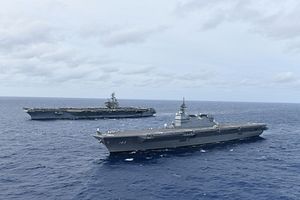The United States’ Navy’s only forward-deployed aircraft carrier strike group, led by flagship USS Ronald Reagan, conducted bilateral exercises with Japan’s largest warship this week in the South China Sea, according to statements released by both countries.
JS Izumo, the lead ship of the Izumo-class of Japanese Maritime Self-Defense Force multi-purpose destroyers, joined the U.S. aircraft carrier for combat training. A U.S. 7th Fleet statement described the vessels’ activities in the South China Sea as a “cooperative deployment.”
MSDF vessels JS Murasame and JS Akebono also accompanied JS Izumo. A Japanese officer was stationed on board USS Ronald Reagan during the exercises as well.
“Having a Japanese liaison officer aboard to coordinate our underway operations has been beneficial and efficient,” said Lt. Mike Malakowsky, a tactical actions officer on USS Ronald Reagan, according to a 7th Fleet statement.
“As we continue to operate together with the JMSDF, it makes us a cohesive unit. They are an integral part of our Strike Group that doubles our capability to respond to any situation.”
The ships “conducted communication checks, tactical maneuvering drills and liaison officer exchanges designed to address common maritime security priorities and enhance interoperability at sea,” according to the U.S. Navy.
The United States and Japan conducted their first bilateral exercise in the South China Sea in 2015, amid growing concern about Chinese activities in the disputed sea.
Japan, the United States’ treaty ally, has increasingly sent its warships to join in bilateral and multilateral exercises across the Indo-Pacific region.
Tokyo has not joined the United States or conducted freedom of navigation operations in the South China Sea of its own, but its vessels have regularly exercised and sailed with the U.S. Navy.
“The time we are able to spend at sea training and operating with our partners in the Japan Self Defense Forces is invaluable,” Capt. Pat Hannifin, USS Ronald Reagan‘s commanding officer said in a 7th Fleet release.
“Our alliance has never been stronger, and it’s never been more important to this region than right now.”
USS Ronald Reagan, forward deployed with the U.S. 7th Fleet in Yokosuka, Japan, is currently on an extended deployment to the Western Pacific and the South China Sea.
JS Izumo will be modified by Japan to carry the F-35B, the short take-off and vertical landing variant of the U.S.-made fifth-generation multi-role stealth fighter.
The Izumo-class of warships received particular attention during a recent trip to Japan by U.S. President Donald J. Trump at the end of May.
Trump boarded JS Kaga, the second ship of the Izumo-class, with Japanese Prime Minister Shinzo Abe, becoming the first U.S. president to board any Japanese warship.

































